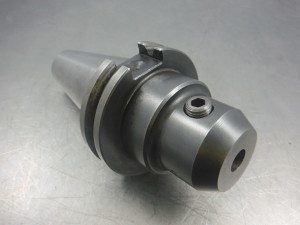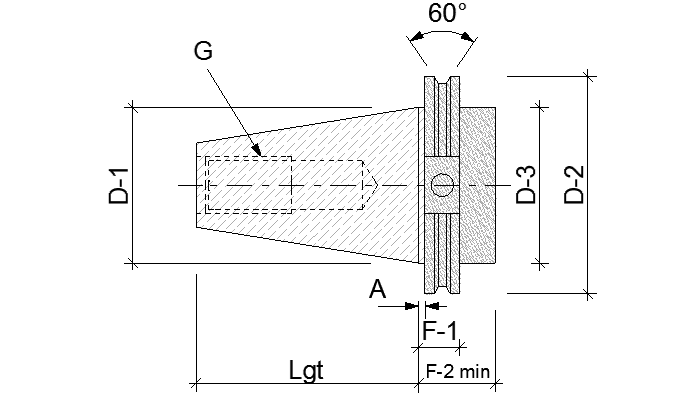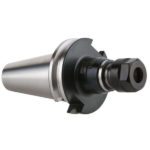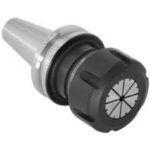 What is a CAT Tool Holder?
What is a CAT Tool Holder?
A tool holder is a device that safely fixes the cutting tool in the spindle of the machine. The cutting tool is mounted into the holder and is tightened, so it does not move during machining. It is used to securely and accurately attach tools of various sizes to the spindle of a milling machine. There are a wide variety of tool holders that are available with many options to choose from. It is important to learn about the different options available so that you can get the right one for your project and your machine. At tool holder exchange our aim is to educate you about the details of the various CAT Tool Holders and act as a resource for your questions about what holders to buy and how to sell your old tool holders you no longer need.
There are three parts of the tool holder. They are the taper, the flange and collet pocket. When you look at the tapered shaft, you will see the threaded hole inside it. Many tool holders have a set screw on the side. The end mill of the tool goes into your tool holder and has a flat that will get tightened into place in the tool holder by using a wrench to tighten the set screw. Some tool holders have chucks attached to hold drill bits which can be tightened up by hand and are further tightened with a key. The collet is another type of tool holder that is available to use. The collet has a ring that can be loosened up with a special toolthat opens up the collet to get your tool in and out. One of the most common standards of tool holders is called CAT.
Cat CNC (Computer Numerically Controlled) Machines have tool release button that makes it easy to release and exchange your CAT tool holder. The CAT40 and CAT50 Tool holder have a Taper, a retention knob (also known as a pull stub), attached to the CAT40 tool holder is a Collet Nut. The Tool Holder has a Drive Flange/Dog Notch which matches up with the CNC machine to secure it in tightly for precision work. It is important to remember always to keep your tool holders clean and free of debris and rust in order to keep it working smoothly.
The CAT mounting style can also be called the V-Flange tool holders, although most of the time they are known as CAT or Caterpillar tooling. CAT tools were developed by engineers at an American company Caterpillar® thirty years ago for use in CNC machinery. CAT tools are the brand name of Caterpillar’s particular tool holders. The caterpillar design has become the national standard for most tool holders within the United States.
CAT Tool Holders will accept both Imperial and metric sized tools. CAT tapered tool holders are similar to BT tapered tool holders. The difference between CAT and BT is the flange style, thickness, and the thread for the pull stud is a different size.
CAT Tooling uses Imperial (English) thread pull studs (retention knobs). Well-known among professionals and widely used, CAT tooling can be found in different sizes: CAT30, CAT40, CAT45, CAT50, CAT60 etc. The number represents the size of taper holder, which is standardized by AMT (Association for Manufacturing Technology). The CAT tool holders range from 30 being the smallest usually and the largest being 60. The higher the number is, the bigger is the taper of your Cat tool holder. The taper size is also defined for all CNC milling machines by the National Machine Tool Builders (NMTB). A good rule of thumb is that you always want to pick the shortest possible tool holder that will work forwhat you are doing. The tool holders fit in the spindle in the CNC machines. The common measurement for the spindle that is used for the CAT version is the 7/24 tapered spindle.
CAT tools are also known as Caterpillar “V-flange”. CAT tool holders are designed as flexible devices that will accommodate different tools within a certain range of sizes. They will accept both imperial and metric sized tools. They consist of a taper (shank) and a holding head (flange). The Morse taper (male part) fits in the spindle’s female coupling, providing precise positioning of the tool and ability to switch it quickly.
The holding head usually uses collets that hold the tool providing concentricity of the cutting tool, as they wrap the tool around the whole circumference. They are perfectly balanced, which is the reason they are so widely used by professionals.
If you are using a tool holder with a collet, do not forget to clean it from debris after each use! A good rule of thumb is to always wipe it down before you put it back into the machine. This ensures you get any missed particles that could interfere with performance. Even a small piece of sawdust can impact the precision of your tools, so make sure not to skimp on this step. Parts of CAT tool holders are very durable and therefore are very safe and reliable. However, they still need to be stored in safe places as anything used for such precise work as CNC milling. They should be carefully replaced in their holders after use so that they do not get dented or scratched which would interfere with their output. Dents and scratches can offset the alignment compromising the precision work of your tool holder.
The You Tube video below by Let’s Machine has a good overview of an introduction to tool holders. The video reviews the various tool holders, how they should be used and the best applications for their use. There are some helpful tips for selecting the right size and type of tool holder as well as how to properly use it. This video is worth the few minutes it takes to watch it.
Cat50, Cat40, Cat30 ER Collet Chucks
- Cat 40 Floating TAP Tool Holder Tier 16
- Cat 30 Tool Holder
ER collet chucks handle a wide range of machining jobs without having to buy new tool holders. Using a Collet Chuck is an easy process. Simply choose the right size collet for the job, set tool depth, and tighten the collet nut and pull stud to the proper torque using a torque wrench and tightening fixture. You will want to make sure that you have it tightened and connected properly.
Collets are available for: drilling, milling, coolant thru, and high-speed applications. Special “DNA” Dead Nuts Accurate collets are used for small drills (6mm and smaller) to maintain T.I.R. at those sizes.
Use “Power Coat” nuts to increase the holding power and safety of your tool holders. The “Power Coat” nut also is balanced and reduces vibration at higher rotation speeds. High holding power extends cutting tool life and improves surface finish.
CAT tool holders do not provide the possibility for spinning the tool inside the collet. Nevertheless, they fit for ATC – Automatic Tool Change, if this technology is supported by your machine.
CAT standard is produced by a variety of companies and is easy to acquire. Some of the companies that make solid well-made tool holders with the CAT standard are Command, Lyndex, Kennametal, Parlec, Techniks, Sandvik, Valenite. They have many tool holder options that you can choose from to find the right fit for your machine and projects.
Dimensions:
|
ANSI B5.50 (from Kennametal catalog 7060) |
||||||||
|
Size |
D–1 | D–2 | D–3 | Lgt | F–1 | F–2 min |
A |
G |
|
40 |
1.750 (44.45) |
2.500 (63.05) |
1.750 (44.45) |
2.687 (68.25) |
0.750 (19.05) |
1.375 (35.00) |
0.125 (3.18) |
5/8-11 |
|
50 |
2.750 (69.85) |
3.875 (98.41) |
2.750 (69.85) |
4.000 (101.60) |
0.750 (19.05) |
1.375 (35.00) |
0.125 (3.18) |
1-8 |
| 60 | 4.250 (107.95) |
5.500 (139.70) |
4.250 (107.95) |
6.375 (161.93) |
0.750 (19.05) |
1.500 (38.10) |
0.125 (3.18) |
1 1/4-7 |
|
ISO 7388-1, DIN 69871, NFE 62540 |
||||||||
|
Size |
D1 | D2 | D3 max | L | F1 | F2 min | A | G |
|
40 |
44.45 | 63.55 | 50 | 68.4 | 15.9 | 35 | 3.2 |
M16 |
| 50 | 69.85 | 97.5 | 80 | 101.75 | 15.9 | 35 | 3.2 |
M24 |
Tool holders built in those two types are usually interchangeable, but there are few differences. Keep this in mind when choosing the right one.

Cat Tool Holders: Bottom Line
Cat tool holders come in a variety of tapers and serve a vast number of purposes in the machine tooling industry. In choosing the best tool holder for your projects you should consider the type of projects you will be working on and what type of tools you will be using. Keep in mind you want to choose the shortest option you can and one that will hold your tool the tightest to get the best performance. If you are not certain which type of CAT tool holders you should purchase for your lathe or CNC machine, please get in touch with us and enable our service representatives to assist you in making the ideal selection for your immediate machine tooling needs. Our friendly and helpful representatives at tool holder exchange have the expertise to assist you with finding the right tool holder for your needs.
If you are in need of CAT 40 or CAT 50 tool holders or if you have CAT 40 or 50 that you want to get off your hands, please contact us using the form on this page. At Toolholder exchange we have many options for you to choose from. We will get back to you right away to help you buy or sell your tool holder.


